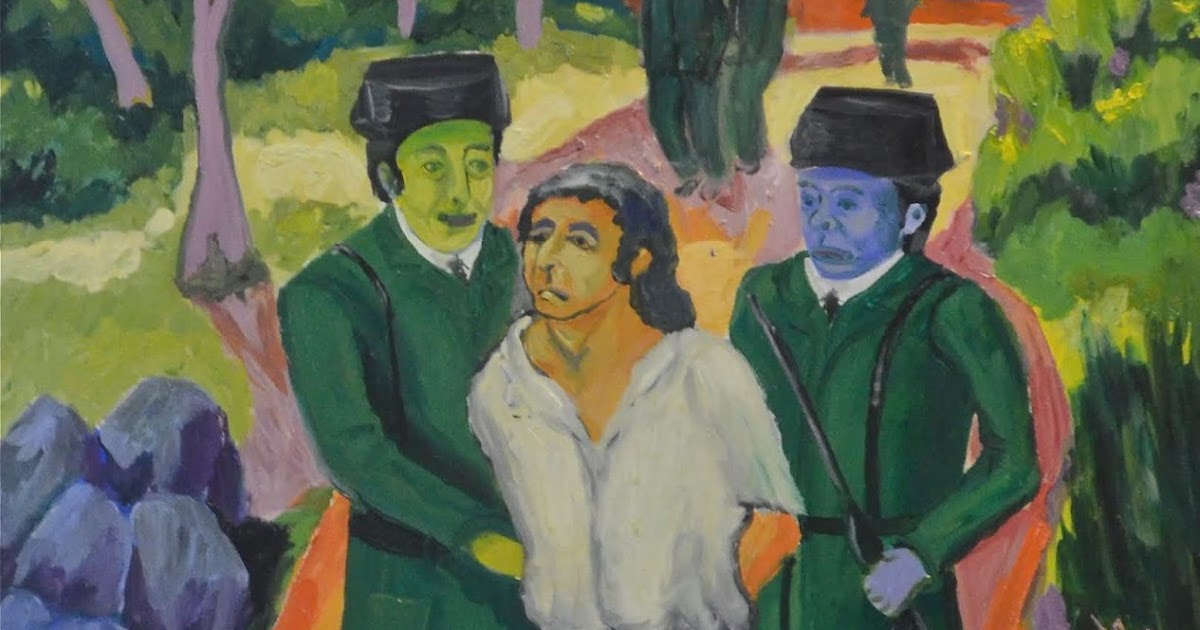6.3 "Prendimiento de Antoñito el Camborio en el camino de Sevilla” – Federico García Lorca
7 min read•june 18, 2024
AP Spanish Literature 💃🏽
24 resourcesSee Units
A literary work titled "Prendimiento de Antoito el Camborio en el camino de Sevilla" describes the arrest of a young man of Gypsy descent named Antonio Torres Heredia. This literary piece explores the context of social and cultural changes.
Context of "Prendimiento de Antoñito el Camborio"
Author Background
Federico García Lorca, a well-known Spanish poet and dramatist, is the author of this literary piece. He was born in 1898 and was a key member of the Generation of '27. This was a group of Spanish writers and artists. He is recognized for his lyrical writing and symbolic poetry that frequently explores themes of love, loss, and the Spanish cultural legacy.

Image Courtesy of Bloodaxe Books
Time and Place
📜 Historical: The poem was released in 1928, a year in which Spain underwent a profound political and social transformation. This was the "Generation of '27," a time of intellectual and creative regeneration as well as rising political unrest that would ultimately result in the Spanish Civil War (1936–1939).
🗺️ Geographic: The action of the novel takes place as the characters travel from an unnamed location to Seville. Seville is a city in southern Spain that is well known for its vibrant cultural traditions and bullfighting customs. An Andalusian landscape sets the behind-the-scenes of a geographic context, which makes mentions of the sea, rivers, mountains, and olive trees.
Societal Atmosphere
👑 Political: The main political component in this literature piece is the Guardia Civil. The Guardia Civil was a Spanish military police agency tasked with upholding law and keeping public order. This helps set the active and present political background in the poem. Particularly in the years preceding the Spanish Civil War, the Guardia Civil was frequently viewed as a sign of dominance and control.
🧑🏽🤝🧑🏻 Socio-economic: The poem's socioeconomic setting is centered on the disadvantaged Gypsy group. Antonio Torres Heredia, better known as Antoñito el Camborio, is a personification of the difficulties and prejudice that Gypsies experience in Spanish society. The interplay between Antoito and the Guardia Civil reflects the social tensions and socioeconomic inequalities of the time.
🎭 Cultural: The context is founded on Andalusian customs. This brings an emphasis on the Gypsy community's cultural legacy. The poem examines issues of cultural authenticity and identity. The deterioration of traditional Gypsy lifestyles in the face of shifting social norms is a large theme in this poem.
Need to Know About "Prendimiento de Antoñito el Camborio"
Characters
The conflict between tradition and modernity, cultural heritage and societal change, is symbolized by Antoñito el Camborio. He stands for the disadvantaged Gypsy group, which experiences prejudice and the erasure of their traditional way of life. The character's detention by the Guardia Civil exemplifies the power relationships and interpersonal conflicts that existed in that era's Spanish culture.

Image Courtesy of AP Spanish Literature
Antonio Torres Heredia (Antoñito el Camborio): The main character of the poem is Antonio Torres Heredia (Antoito el Camborio), a young man of Gypsy descent. He is also part of the Camborios family. He's traveling to Sevilla to see the bullfights. Antoito is a symbol of the difficulties and prejudice that the Gypsy population must deal with.
The Guardia Civil: The Guardia Civil is a military police unit that detains Antoñito el Camborio. The Guardia Civil represents power and authority. This helps encapsulate the shifting social dynamics and the power gap.
The Old Knives: Although they are not specifically mentioned, they are still somewhat referenced to. The poem alludes to "old knives" quivering in the dirt. This can be a reference to the older Gypsy generations. These older Gypsy generations have endured oppression and are now disappearing.
Literary Terms and Devices
It'd be best to familiarize yourself with the following literary terms used in this text:
- In medias res: The poem begins "in medias res" by putting the reader into the action. It tells the story of Antonio Torres Heredia (Antoito el Camborio), who is traveling to Sevilla and is already immersed in his journey and encounters.
- Verso octosílabo (Octosyllabic verse): The poem is written in octosyllabic verses, with eight syllables in each line. This meter contributes to the poem's musicality and cadence while preserving a steady and even flow.
- Rima asonante en los veros pare (Assonant rhyme scheme in the even verses): The poem uses assonant rhyme throughout. Instead of precise consonance, the repetition of vowel sounds gives the poem a melodic aspect that improves its musicality.
- Verso blanco: The poem uses "verso blanco" or blank verse, which is a term for lines of poetry without rhyme. In this instance, it gives the rhyme scheme some diversity and gives the poet a greater opportunity to convey thoughts and feelings.
- Símbolo: Symbols include the vara de mimbre (wicker stick), which represents Antoito's Gypsy origin, and the limones (lemons), which he tosses into the river to symbolize a transformational act.
- Imagen: The poem combines vivid imagery to provide the reader a visual and physical sense of the sceneries. This is seen in instances such as the "verde luna" (green moon), "ramas de un olmo" (elm tree branches), and "montes de plomo" (leaden mountains).
- Alusión: The poem alludes to the Camborios and their presence in the highlands, as well as the cultural and historical background of gypsies. These references encourage a deeper comprehension of the Gypsy population and its customs.
- Ambigüedad (Ambiguousness): The poem has parts that leave room for interpretation. There can also be various meanings through different modes of interpretation. The open-ended description of the guardias civiles (civil guards) and the outcome of Antoito el Camborio are abigiuous.
- Verosimilitud: By depicting the social and cultural reality of the Gypsy community, the interaction with the Guardia Civil, and the struggles encountered by marginalized people in society, the poem gives a sense of verisimilitude.
Summary of "Prendimiento de Antoñito el Camborio"
The poem "Prendimiento de Antoñito el Camborio en el camino de Sevilla" describes the trip of a young man from the Gypsy community named Antonio Torres Heredia, also known as Antoñito el Camborio. Antoñito travels to Sevilla in order to see a bullfight, a large part of Spanish culture.
Antoñito's interaction with the Guardia Civil, the Spanish military police force, overtakes his travels. His eventual arrest results from an escalating conflict with the police. The conflict between various socioeconomic and cultural sectors is symbolized by this confrontation between Antoñito, who stands in for the marginalized Gypsy community, and the Guardia Civil.
The poem touches on a number of significant issues. First and foremost, the character of Antoito, who celebrates his Gypsy origin and cultural background, explores the issue of identity. The prejudices and hardships faced by marginalized communities within a larger societal environment are highlighted by the discrimination suffered by Antoito, as demonstrated by his imprisonment.
The poem also explores the conflict between the traditional Gypsy lifestyle and the then-evolving mainstream conventions. While the presence of the Guardia Civil signifies the rise of a more authoritarian and conformist society, Antoñito's desire to watch the bullfight indicates his attachment to cultural traditions.
Themes in "Prendimiento de Antoñito el Camborio"
Las sociedades en contacto (Societies in contact)
The poem "Prendimiento de Antoñito el Camborio en el camino de Sevilla" describes the interaction between the Guardia Civil and the marginalized Gypsy population. Antoñito represents the Gypsy community and the oppression they faced. This encounter highlights the tensions that develop when societies interact, symbolizing the clash and interplay between many social groups.
Las relaciones de poder (Power relations)
The poem clearly illustrates the power relationships between the Guardia Civil and Antoñito el Camborio. The state's authority, the Guardia Civil, exercises supervision over the underprivileged Gypsy community. This disparity in power is a reflection of the oppressive nature of the prevailing social order as well as the unequal allocation of authority.
Las divisiones socioeconómicas (Socioeconomic divisions)
In "Prendimiento de Antoñito el Camborio en el camino de Sevilla," the socioeconomic divide between the Gypsy population and the Guardia Civil's authority is discussed. Due to his Gypsy heritage and contact with the Guardia Civil, Antoñito brings attention to the social injustices and economic disparities that exist in society, emphasizing how oppressed some groups are.
El individuo en su entorno (The individual in their environment)
The poem focuses on Antoñito el Camborio's personal journey and interacts with the societal influences that form his identity. The encounters that Antoñito has with the Guardia Civil and his surroundings show how the environment affects a person's growth. This helps highlight the interactions between himself and the outside elements that go into his sense of identity and place in the world.
Significance of "Prendimiento de Antoñito el Camborio"
Since it examines the social, cultural, and historical context of the underrepresented Gypsy minority in Spain, "Prendimiento de Antoñito el Camborio en el camino de Sevilla" is incredibly important. Antoñito el Camborio's interaction with the Guardia Civil serves as a vehicle for the poem's exploration of discrimination, power relationships, and the struggle between tradition and society progress. It comments on societal injustices and the defense of cultural uniqueness against obstructive forces. The poem's use of literary devices including vivid imagery, symbolism, and rhythmic structure captures readers' attention and draws them into the protagonist's nuanced experiences.
The poem's investigation of power dynamics, socioeconomic disparities, and the relationship of a person with their surroundings are made clear by the analysis of the poem. The confrontation between Antoñito and the Guardia Civil serves as a reminder of the unequal power structures and oppressive nature of the prevailing socioeconomic structure. The poem emphasizes the differences in society by highlighting the socioeconomic gaps between the Gypsy community and the authorities. The poem also examines the experience of the individual as Antoñito travels. His travel highlighting the influences of societal factors on his feeling of self and belonging. "Prendimiento de Antoñito el Camborio en el camino de Sevilla" is a great literary work that inspires contemplation on social inequality and the difficulties of cultural preservation through its structure and use of poetic devices and the author's abilities to connect it all together.
“Prendimiento de Antoñito el Camborio en el camino de Sevilla” is an important work in Spanish literature. The poem serves as a powerful reminder of the impact of political and social unrest on individuals, and of the importance of speaking out against injustice. The story speaks to the everyday struggles faced by marginalized communities and serves as a reminder that these issues are still relevant even today.
Browse Study Guides By Unit
🏇Unit 1 – La época medieval
🛳Unit 2 – El siglo XVI
🖌Unit 3 – El siglo XVII
🎨Unit 4 – La literatura romántica, realista y naturalista
🤺Unit 5 – La Generación del 98 y el Modernismo
🎭Unit 6 – Teatro y poesía del siglo XX
🌎Unit 7 – El Boom latinoamericano
🗣Unit 8 – Escritores contemporáneos de Estados Unidos, y España

Fiveable
Resources
© 2025 Fiveable Inc. All rights reserved.